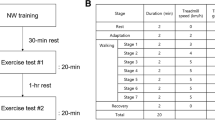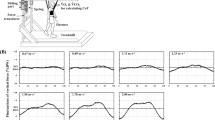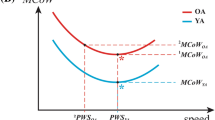Abstract
Walking on a treadmill with Body Weight Unloading (BWU), which has been successfully used on patients with neurological conditions, may also be used as a training tool to increase walking speed in healthy individuals. We hypothesised that BWU enables individuals to walk at a faster speed on a treadmill than they would do in normal gravity conditions without increasing their effort and with an increase in both stride length (SL) and stride frequency (SF). Oxygen uptake, heart rate (HR), SL and SF of six older women (mean ± SD; 70 ± 4 years) and six young women (26 ± 3 years) were measured during treadmill walking at three self-selected speeds (comfortable, slow and fast) and three different percentages of BWU (0, 20 and 40%). No significant differences were found between the groups in any self-selected walking speeds and any of the other variables. The combined data of the two groups showed that walking energy cost per unit of time (WECt) and HR at fast speed with 40% of BWU (258 ± 60 J kg−1 min−1 and 95 ± 15 beats min−1, respectively) were similar to those measured at comfortable speed with no BWU (273 ± 47 J kg−1 min−1 and 101 ± 16 beats min−1, respectively). Also SL and SF increased significantly with speed (P < 0.017) at any given percentage of BWU. The results suggest that 40% of BWU enables both young and older women to walk at a faster speed on a treadmill without increasing their effort and with an increase in both SL and SF.




Similar content being viewed by others
References
Bernardi M, Canale I, Castellano V, Di Filippo L, Felici F, Marchetti M (1995) The efficiency of walking of paraplegic patients using a reciprocating gait orthosis. Paraplegia 33:409–415
Bernardi M, Macaluso A, Sproviero E, Castellano V, Coratella D, Felici F, Rodio A, Piacentini F, Marchetti M, Ditunno JF (1999) Cost of walking and locomotor impairment. J Electromyogr Kinesiol 9:149–157
Bertram JEA, Ruina A (2001) Multiple walking speed–frequency relations are predicted by constrained optimization. J Theor Biol 209(4):445–453
Browning RC, Kram R (2005) Energetic cost and preferred speed of walking in obese vs. normal weight women. Obes Res 13:891–899
Bunc V, Dlouha R (1997) Energy cost of treadmill walking. J Sports Med Phys Fitness 37:103–109
Colby SM, Kirkendall DT, Bruzga RF (1999) Electromyographic analysis and energy expenditure of harness supported treadmill walking: implications for knee rehabilitation. Gait Posture 10:200–205
Di Prampero PE (1986) The energy cost of human locomotion on land and in water. Int J Sports Med 5:348–352
Dietz V, Colombo G, Jensen L, Baumgartner L (1995) Locomotor capacity of spinal cord in paraplegic patients. Ann Neurol 37:574–582
Donelan JM, Kram R (1997) The effect of reduced gravity on the kinematics of human walking: a test of the dynamic similarity hypothesis for locomotion. J Exp Biol 200:3193–3201
Donelan JM, Shipman DW, Kram R, Kuo AD (2004) Mechanical and metabolic requirements for active lateral stabilization in human walking. J Biomech 37:827–835
Durnin JV, Womersley J (1974) Body fat assessed from total body density and its estimation from skinfold thickness: measurements on 481 men and women aged from 16 to 72 years. Br J Nutr 32:77–97
Falls HB, Humphrey LD (1976) Energy cost of running and walking in young women. Med Sci Sports 8:9–13
Farley CT, McMahon TA (1992) Energetics of walking and running: insights from simulated reduced-gravity experiments. J Appl Physiol 73:2709–2712
Fritz JM, Erhard RE, Vignovic M (1997) A nonsurgical treatment approach for patients with lumbar spinal stenosis. Phys Ther 77:962–973
Gazzani F, Bernardi M, Macaluso A, Coratella D, Ditunno JF Jr, Castellano V, Torre M, Macellari V, Marchetti M (1999) Ambulation training of neurological patients on the treadmill with a new walking assistance and rehabilitation device (WARD). Spinal Cord 37:336–344
Grabowski A, Farley CT, Kram R (2005) Independent metabolic costs of supporting body weight and accelerating body mass during walking. J Appl Physiol 98(2):579–583
Greig C, Butler F, Skelton D, Mahmud S, Young A (1993) Treadmill walking in old age may not reproduce the real life situation. J Am Geriatr Soc 41:15–18
Greig CA, Young A, Skelton DA, Pippet E, Butler FM, Mahmud SM (1994) Exercise studies with elderly volunteers. Age Ageing 23:185–189
Griffin TM, Tolani NA, Kram R (1999) Walking in simulated reduced gravity: mechanical energy fluctuations and exchange. J Appl Physiol 86(1):383–390
Hausswirth C, Bigard AX, Le Chevalier JM (1997) The Cosmed K4 telemetry system as an accurate device for oxygen uptake measurements during exercise. Int J Sports Med 18:449–453
Himann JE, Cunningham DA, Rechnitzer PA, Paterson DH (1988) Age-related changes in speed of walking. Med Sci Sports Exerc 20:161–166
Hunter D, Smith CE, Murray JM, Murray TD (1995) Energy expenditure of below-knee amputees during harness-supported treadmill ambulation. J Orthop Sports Phys Ther 21:268–276
Kerrigan DC, Todd MK, Della CU, Lipsitz LA, Collins JJ (1998) Biomechanical gait alterations independent of speed in the healthy elderly: evidence for specific limiting impairments. Arch Phys Med Rehabil 79:317–322
Malatesta D, Simar D, Dauvilliers Y, Candau R, Borrani F, Prefaut C, Caillaud C (2003) Energy cost of walking and gait instability in healthy 65- and 80-yr-olds. J Appl Physiol 95:2248–2256
Mangione KK, Axen K, Haas F (1996) Mechanical unweighting effects on treadmill exercise and pain in elderly people with osteoarthritis of the knee. Phys Ther 76:387–394
Martin PE, Rothstein DE, Larish DD (1992) Effects of age and physical activity status on the speed-aerobic demand relationship of walking. J Appl Physiol 73:200–206
McCann DJ, Adams WC (2002) A dimensional paradigm for identifying the size-independent cost of walking. Med Sci Sports Exerc 34:1009–1017
Mian OS, Thom JM, Ardigo LP, Narici MV, Minetti AE (2006) Metabolic cost, mechanical work, and efficiency during walking in young and older men. Acta Physiol (Oxford) 186:127–139
Murray JM, Hunter DL, Paper MW, Kelsey DD, Murray TD (1993) Determination of the physiological effects of unloaded treadmill exercise. J Cardiopulm Phys Ther 4(2):13–16
Nagasaki H, Itoh H, Hashizume K, Furuna T, Maruyama H, Kinugasa T (1996) Walking patterns and finger rhythm of older adults. Percept Mot Skills 82:435–447
Pearce ME, Cunningham DA, Donner AP, Rechnitzer PA, Fullerton GM, Howard JH (1983) Energy cost of treadmill and floor walking at self-selected paces. Eur J Appl Physiol Occup Physiol 52:115–119
Ralston HJ (1958) Energy-speed relation and optimal speed during level walking. Int Z Angew Physiol 17:277–283
Samson MM, Crowe A, de Vreede PL, Dessens JA, Duursma SA, Verhaar HJ (2001) Differences in gait parameters at a preferred walking speed in healthy subjects due to age, height and body weight. Aging (Milano) 13:16–21
Sekiya N, Nagasaki H (1998) Reproducibility of the walking patterns of normal young adults: test-retest reliability of the walk ratio (step-length/step-rate). Gait Posture 7:225–227
Skelton DA, Greig CA, Davies JM, Young A (1994) Strength, power and related functional ability of healthy people aged 65–89 years. Age Ageing 23:371–377
Threlkeld AJ, Cooper LD, Monger BP, Craven AN, Haupt HG (2003) Temporospatial and kinematic gait alterations during treadmill walking with body weight suspension. Gait Posture 17:235–245
Visintin M, Barbeau H, Korner-Bitensky N, Mayo NE (1998) A new approach to retrain gait in stroke patients through body weight support and treadmill stimulation. Stroke 29:1122–1128
Waters RL, Hislop HJ, Perry J, Thomas L, Campbell J (1983) Comparative cost of walking in young and old adults. J Orthop Res 1:73–76
Winter DA, Patla AE, Frank JS, Walt SE (1990) Biomechanical walking pattern changes in the fit and healthy elderly. Phys Ther 70:340–347
Zamparo P, Francescato MP, De Luca G, Lovati L, di Prampero PE (1995) The energy cost of level walking in patients with hemiplegia. Scand J Med Sci Sports 5:348–352
Zarrugh MY, Todd FN, Ralston HJ (1974) Optimization of energy expenditure during level walking. Eur J Appl Physiol Occup Physiol 33:293–306
Acknowledgments
The study was financially supported by a grant from The Health Foundation.
Author information
Authors and Affiliations
Corresponding author
Rights and permissions
About this article
Cite this article
Thomas, E.E., De Vito, G. & Macaluso, A. Physiological costs and temporo-spatial parameters of walking on a treadmill vary with body weight unloading and speed in both healthy young and older women. Eur J Appl Physiol 100, 293–299 (2007). https://doi.org/10.1007/s00421-007-0428-5
Accepted:
Published:
Issue Date:
DOI: https://doi.org/10.1007/s00421-007-0428-5




